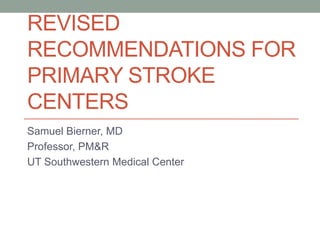
Primary stroke centers 8 26-11
- 1. REVISED RECOMMENDATIONS FOR PRIMARY STROKE CENTERS Samuel Bierner, MD Professor, PM&R UT Southwestern Medical Center
- 5. Brain Attack Coalition report Stroke 2011;42:2651-2665 First Recommendations Revised Recommendations • 2000 • 2011
- 6. Burden of stroke United States Causes of death • 795,000 persons per year • 4th Leading Cause of have a new or recurrent Death (down from 3rd) stroke • Major cause of adult disability
- 7. 2 Levels of Stroke Centers CSC (Comprehensive Stroke PSC (Primary Stroke Center) Center) • Provide acute care to • Large or complex stroke; most patients with stroke • Hemorrhagic stroke; • Use some acute stroke • Requiring specialized therapies; treatments • Admit the patient to a (endovascular, surgery) stroke unit • Multi-system involvement • Neurosurgical services immediately available
- 8. Major Elements of a PSC Patient Care Administrative/Support • Acute Stroke Team (AST) • Institutional Support • Written care Protocols • PSC Director, call • Emergency medical services reimbursement (EMS); • Stroke Registry with • Emergency Department; outcomes and QI • Stroke Unit; components; • Educational Programs for • Neurosurgical Services; Public and Professionals • Imaging Services; • Certification • Rehabilitation Services; • Participate in Stroke System • Laboratory Services of care
- 9. Acute Stroke • At bedside within 15 Team MINUTES Initiate diagnostic and • At least 2 members Immediate care At least • If a rapid response team from 1 Physician with expertise in cerebrovascular outside hospital, must be disease; 1 other healthcare able to respond in less than provider (nurse, PA or NP) or = 15 minutes Available 24/7 basis
- 10. Class I A • Written Care Protocols Recom- • Swallow evaluation before mendation feeding • DVT prophylaxis
- 15. EMS • “drip and ship” • Los Angeles Pre- protocols for use of hospital Stroke Screen intravenous tPA; • Establish time of • Inclusion of “air onset; ambulances” is a new • Transport patient’s recommendation; medications with them • New technologies: to hospital; telemedicine, telestrok • Cooperative e/teleradiology educational activities 2 x per year
- 16. Emergency Department • ED personnel must be • Key ED personnel trained in diagnosis should participate in and treatment of all educational activities types of acute stroke at least 2 times per • -Use of tPA in acute year; ischemic stroke • 8 hours CEU per year; • Door-to-physician • Log of patients and assessment time of 15 door to physician times minutes maintained
- 17. Stroke Unit • Defined group of beds • Stroke Units reduced • Step-down unit with death by 17 to 28%; nurse: patient ratio of 1:3. • 7% increase in ability • Written care protocols to live at home; • Nursing expertise in NIHSS and vital signs • 8% reduction in length checked every 1-2 hrs. of stay • Multi-channel telemetry (BP, P, O2, Resp)
- 18. Neurosurgical Services • Ventricular drainage • NSG care must be catheter placement; available within 2 • Evacuation of a hours of the time it is hematoma; deemed clinically • Decompressive necessary hemicraniectomy for massive cerebral infarction
- 19. Cerebral and Cerebrovascular Imaging • Must be able to • Brain MRI may be perform head CT used in lieu of head CT within 25 minutes of if same time the order being written; parameters can be • Physician can read met. scan within 20 minutes • Vascular imaging of its completion (MRA or CTA) should be available for those patients who might benefit from this testing
- 20. Cardiac Imaging • Significant % of • TTE ischemic strokes are • TEE due to cardio-embolic • Cardiac MRI disease: • PSC should have at • Atrial fibrillation; least 1 modality • Myocardial infarction; available to image the • Valvular disease; heart for all admitted • Aortic Arch plaques; patients with stroke.
- 21. Laboratory Services • Blood chemistries • ECG • Coagulation studies • Chest X-ray • Pregnancy test (when • HIV test appropriate) • Pregnancy test • Studies must be • Drug toxicology test completed within 45 • All must be done minutes of being ordered
- 22. Rehabilitation Services • TJC (Joint • Early assessment of Commission) has needs (PT, OT, ST) included rehabilitation • Early assessment of consideration as a rehabilitation potential disease performance • Early initiation of basic measure for PSC rehabilitation activities • Does not have to have inpatient unit (IRF)
- 23. TJC Certification Program • Launched in 2004 • UTSW and Parkland • More than 800 PSC’s are both certified in current network • Must select 2 relevant patient-care parameters for benchmarking each year • Quality Improvement – Stroke Registry or Database
